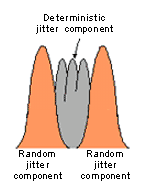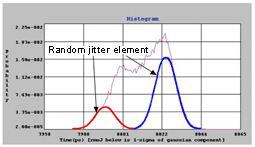Glossary - alphabet order - "J"
Jitter
Time domain deviation or fluctuation that occurs in a signal waveform.
- Period jitter (peak to peak)
Deviation or fluctuation in the length of one cycle of a signal; peak-to-peak jitter is the difference between the maximum and minimum cycle lengths of a signal. - Cycle to Cycle Jitter
Cycle to cycle jitter: The shift or fluctuation that occurs in the difference between adjacent single cycles of a signal. The absolute value of the maximum cycle difference is sometimes referred to as Peak to Peak, and the standard deviation of the cycle difference distribution is sometimes referred to as RMS. Cycle to Cycle Jitter = T1 -T2
- Random jitter
Jitter caused by thermal noise or flicker noise. The distribution of jitter shows a normal distribution, and the standard deviation of the distribution is used as the jitter value. - Deterministic Jitter
Jitter induced by circuit design, electromagnetic induction, and external environment. It is characterized by being finite and predictable (deterministic). In the presence of this jitter, the distribution of jitter appears as multiple overlapping normal distributions (random jitter), and the difference between the maximum and minimum of the median of these normal distributions is the jitter value.


Random jitter and deterministic jitter Example of random jitter - Total Jitter (TJ)
The maximum amount of jitter that can occur with a given probability, calculated as TJ = DJ + n × RJ, where DJ is a finite value for deterministic jitter, but RJ is normally distributed, so the possible values are infinite. Therefore, the probability of error (BER) is set for TJ, and the value of n is determined according to that probability. n ≈ 14 for BER = 10^-12. - Phase jitter
Jitter derived from phase noise. Phase noise is frequency instability expressed in the frequency domain, and phase jitter is obtained by integrating this and converting it to the time domain.
